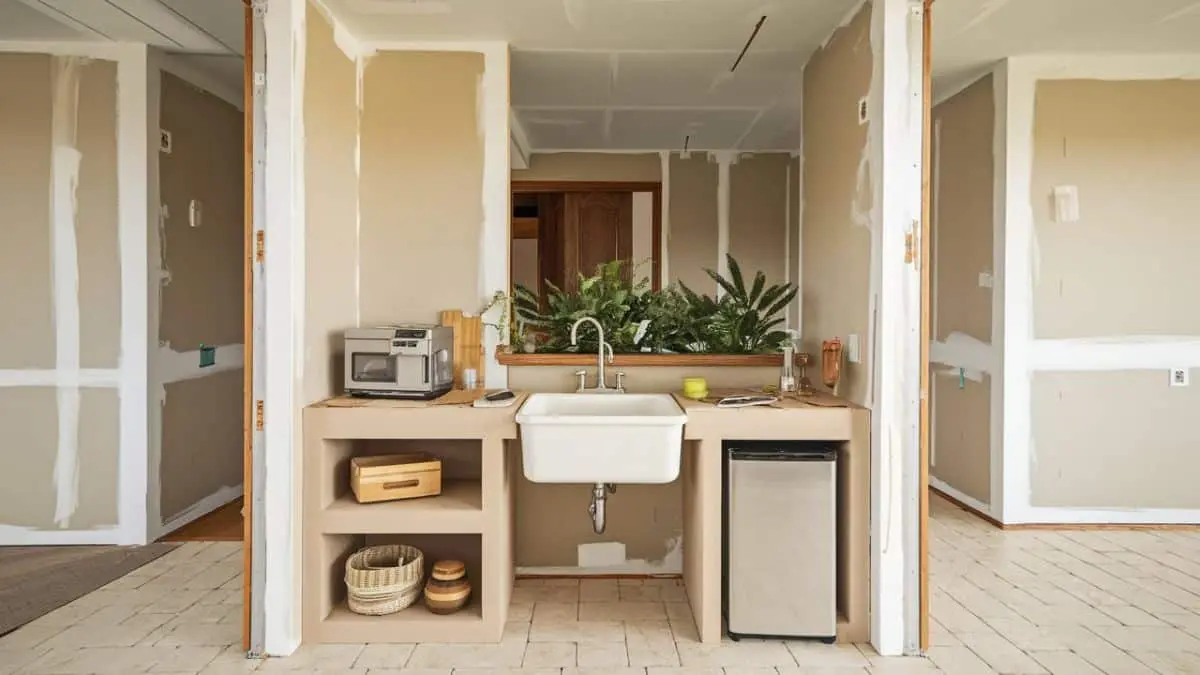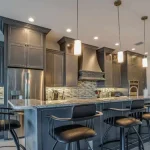When undergoing a kitchen remodel, your home can quickly become chaotic. Cooking, cleaning, and meal prep may seem impossible without access to your usual kitchen setup. However, creating a temporary kitchen can help you maintain your routine while the remodel is in progress.
A temporary kitchen is a designated space within your home where you can continue basic cooking and food preparation tasks. This guide will walk you through every step of setting up a temporary kitchen that is functional, safe, and efficient. By following these detailed tips, you’ll be able to keep meal prep simple, maintain hygiene, and reduce stress during your renovation project.
Whether you’re planning a full kitchen renovation or just a partial upgrade, setting up a temporary kitchen will ensure that your home remains livable and comfortable throughout the process. Let’s explore how to plan, set up, and manage this space to meet your family’s needs during the remodel.
Planning Your Temporary Kitchen
Before starting your kitchen remodel, careful planning is essential to ensure that you and your family can continue to prepare meals without major disruptions. A well-thought-out temporary kitchen can provide the convenience you need during construction. This section will guide you through choosing the best location, assessing your family’s specific needs, and setting a realistic budget for your temporary setup.
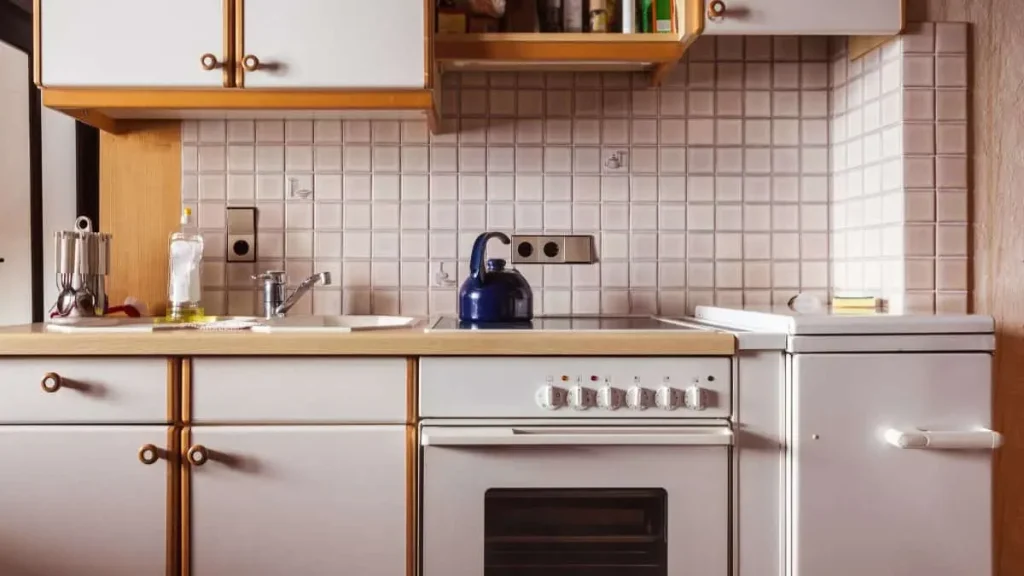
Choosing the Ideal Location
The location of your temporary kitchen plays a vital role in ensuring comfort and functionality. Start by evaluating different areas in your home that are easy to access and have nearby electrical outlets or plumbing. Indoor options, such as a dining room, garage, or basement, can serve as suitable spaces, offering protection from weather and better access to utilities. Each option has its pros and cons. For example, a dining room offers convenience but might lack sufficient ventilation, while a basement or garage may offer more space but could be far from the rest of the living area.
In some cases, especially if you live in a region with favorable weather, an outdoor setup could be a great alternative. A patio or deck can serve as an open-air kitchen with a grill or portable stove, though it requires planning for bad weather. When setting up outside, think about shelter options, such as canopies, to protect your kitchen from rain or excessive sunlight.
In both indoor and outdoor setups, there are a few key considerations to keep in mind. First, try to place your kitchen close to a water source and electrical outlets for convenience. Second, ensure there’s good ventilation, particularly if you’ll be cooking indoors. Lastly, choose a location that minimizes disruption to other daily activities in your home, allowing your family to continue their routines smoothly.
Assessing Your Family’s Needs
Your household’s size and makeup will influence your temporary kitchen’s setup. If you have a large family, for instance, you’ll need to plan for more food storage, a larger workspace, and additional seating for meals. Smaller households can make do with fewer appliances and less counter space.
It’s also important to consider dietary requirements. Families with young children, elderly members, or those with special dietary needs may need specific kitchen tools, appliances, or additional storage for specialized ingredients. If someone in your household has food allergies, pay close attention to organizing your temporary kitchen to prevent cross-contamination.
Moreover, assess how your daily routine will be affected. If you’re used to preparing large meals, consider scaling back and focusing on simpler recipes that require fewer appliances. Think about how you’ll handle breakfast, lunch, and dinner efficiently while ensuring you have the necessary tools for snacks or drinks during the day.
Setting a Realistic Budget
Creating a temporary kitchen doesn’t need to be costly, but it’s important to set a budget that accounts for your specific needs. Start by identifying which items you already have, like small appliances, tables, or storage units. Then, determine which essential items you’ll need to purchase, such as portable stoves, folding tables, or compact refrigerators. It’s helpful to prioritize essential tools and appliances that will make your temporary kitchen functional.
Planning for unexpected costs is also a key consideration. Even with the best planning, unforeseen expenses may arise, like buying additional storage containers, temporary flooring to protect your home, or an extra extension cord. Setting aside a portion of your budget for these unplanned purchases can help you avoid overspending.
To save money, consider borrowing or renting items from friends or family, especially for larger appliances or furniture that may only be needed temporarily. You could also repurpose existing furniture to create extra counter space or shelving. If your remodel is taking place over a longer period, investing in a few high-quality, durable items might make more sense than buying cheap, short-term options.
Recommended: How to Achieve a Stunning Kitchen Makeover on a Budget
Creating a Functional Temporary Kitchen Layout
A functional kitchen layout is key to ensuring that your temporary space serves your needs effectively during the remodel. While the space may be limited, strategic planning of your layout can maximize efficiency and comfort. From optimizing counter space to organizing storage and ensuring proper ventilation, these steps will help you design a temporary kitchen that supports easy meal preparation and cleaning without feeling cramped or chaotic.
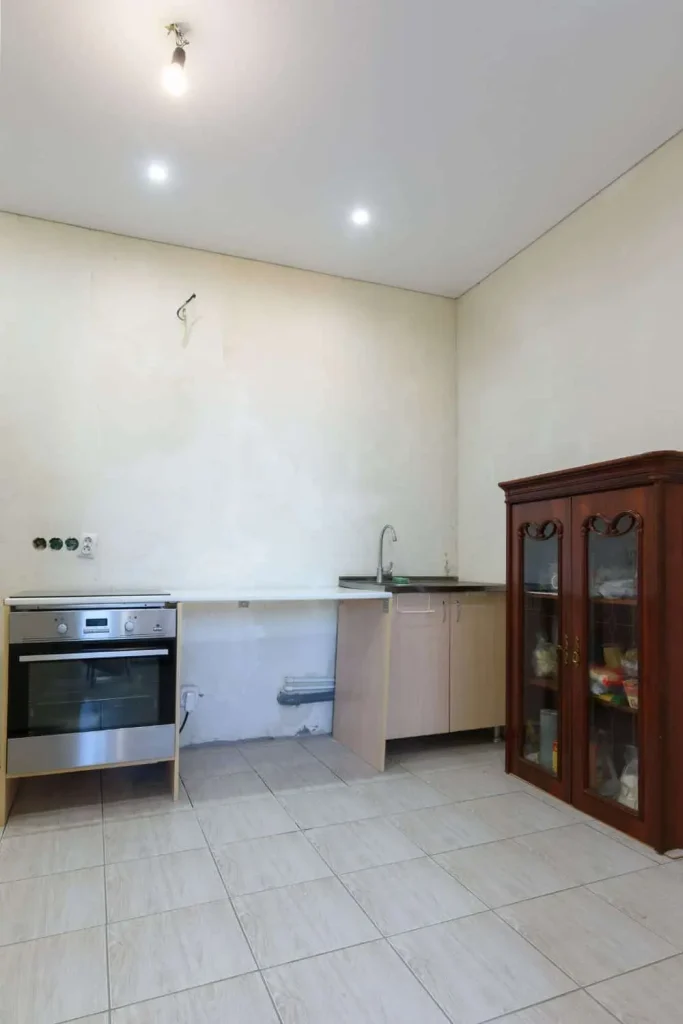
Optimizing Counter Space
Counter space is one of the most valuable assets in any kitchen, and this becomes especially true in a temporary setup where space is limited. Since a temporary kitchen will likely lack traditional countertops, you will need to get creative with available surfaces. Start by designating a few sturdy flat surfaces for food prep. Portable folding tables, kitchen carts, or even a large, stable cutting board placed over a compact appliance can serve as makeshift counters.
It’s important to prioritize workflow efficiency when setting up your counter space. Arrange your most-used items—such as a cutting board, knife set, and frequently used small appliances—within easy reach. This reduces the need to move back and forth between areas while cooking, making the space feel more efficient despite its temporary nature.
If your counter space is extremely limited, think vertically. Adding stackable shelves or using wall-mounted hooks for lightweight utensils and small items can free up room on your primary work surfaces. Additionally, keep clutter to a minimum by storing away items you don’t use every day, so your limited counter space remains available for essential tasks.
Organizing Storage
Storage in a temporary kitchen can be a challenge, as it’s unlikely you’ll have access to the built-in cabinets or pantry space available in a regular kitchen. To make the most of your temporary setup, focus on creating an organized system that maximizes the available storage.
Begin by grouping items based on frequency of use. For example, keep everyday essentials like pots, pans, and utensils easily accessible in open shelving or storage bins near your cooking area. Less frequently used items can be stored in boxes or crates in a nearby room or under tables, out of sight but still within reach when needed. Consider labeling containers for easy identification, which can save time when you’re looking for a specific tool or ingredient.
Utilizing vertical space can significantly increase your storage capacity. If you’re working in a space with walls, consider installing temporary shelving units or using over-the-door organizers for items like spices, cutlery, or cleaning supplies. You can also repurpose household items such as baskets, hanging racks, or collapsible containers to keep your kitchen organized. The goal is to create a system that allows for easy access without overcrowding your workspace.
Ensuring Proper Ventilation
Proper ventilation is essential to maintaining a safe and comfortable temporary kitchen environment, especially if you’ll be using cooking appliances that produce heat, steam, or smoke. A lack of ventilation can lead to unpleasant odors, excessive humidity, and even potential safety hazards.
If you’ve set up your temporary kitchen in an area without a built-in ventilation system, such as a garage or basement, consider portable solutions. Small fans or portable air purifiers can help circulate air and reduce humidity. If your kitchen is indoors, try to place your cooking station near windows that can be opened to allow fresh air in and cooking fumes out. It’s especially important to ensure that your stove or cooktop has some form of ventilation, as the buildup of steam and smoke can make the environment uncomfortable and potentially hazardous over time.
For outdoor kitchens, ventilation is less of a concern since the open air naturally disperses smoke and fumes. However, it’s still important to position your cooking appliances in an area that won’t trap heat or smoke near seating areas or other parts of the house. Always be mindful of wind direction when cooking outdoors, especially when using portable grills or gas stoves, to avoid blowing smoke into living areas or toward neighbors.
Stocking Your Temporary Kitchen
Once you’ve set up the physical layout of your temporary kitchen, the next step is to stock it with the essentials needed to continue cooking and maintaining a functional household during the remodel. While the space may be more limited than your usual kitchen, careful selection of pantry staples, essential utensils, cookware, and cleaning supplies will help you stay organized and prepared for daily meal preparation. The goal is to ensure you have everything you need without overcrowding your temporary space.
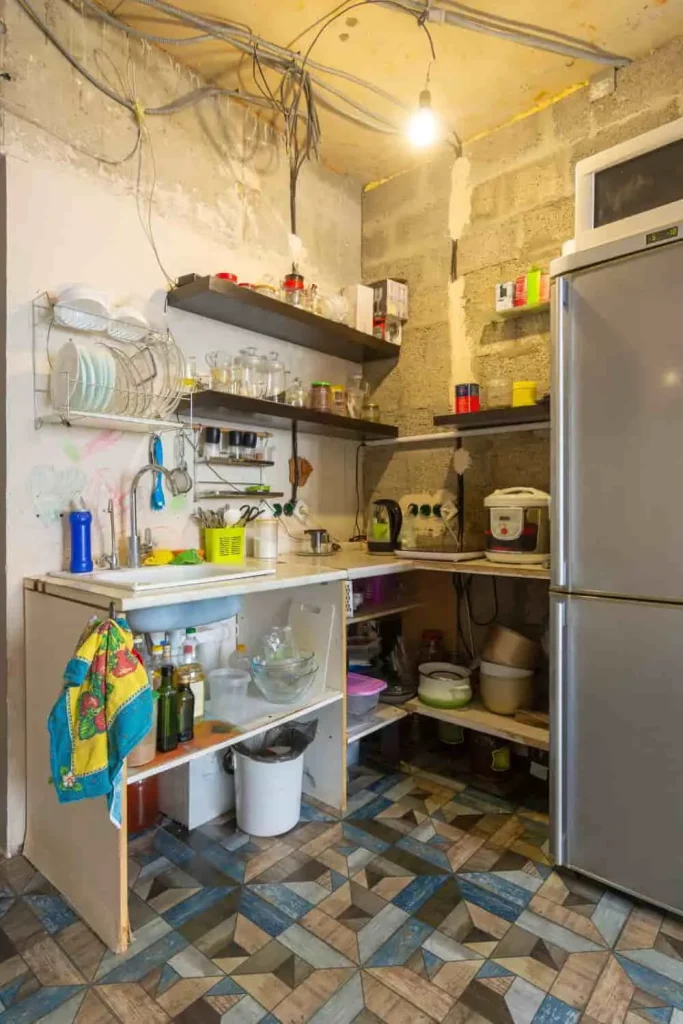
Pantry Staples
A well-stocked pantry is the backbone of any functional kitchen, and this is equally true for a temporary setup. The challenge, however, lies in selecting a reduced list of pantry staples that will allow you to prepare a variety of meals without taking up too much space. Start by choosing versatile ingredients that are shelf-stable and can be used in multiple recipes. Items like rice, pasta, canned vegetables, beans, and sauces can serve as the foundation for many meals. Dried goods such as lentils, quinoa, and oats are also good choices due to their long shelf life and ease of preparation.
It’s essential to consider how much space you have for pantry storage. In a temporary kitchen, you won’t have the luxury of large cabinets, so focus on compact packaging and avoid stocking up on bulk items unless absolutely necessary. Keep an eye on perishables such as bread or fresh produce. Since your temporary kitchen may have a smaller refrigerator or limited storage for fresh goods, it’s best to buy these items in smaller quantities and more frequently.
Spices and condiments are also important but should be limited to a basic selection. Focus on multipurpose seasonings like salt, pepper, garlic powder, and a few favorite herbs that can complement a wide range of dishes. Having a handful of essential sauces—such as soy sauce, olive oil, and a favorite hot sauce—will help elevate simple meals without overwhelming your storage space.
Essential Utensils and Cookware
In a temporary kitchen, it’s crucial to limit your utensils and cookware to the most essential items while still enabling you to prepare a variety of meals. Versatility is key when choosing these tools. A small selection of high-quality, multi-functional cookware—like a skillet, a saucepan, and a stockpot—can be used for most cooking tasks. For those relying on small appliances such as a microwave or toaster oven, make sure to include heat-safe dishes and containers that work well with those appliances.
When it comes to utensils, focus on the basics. A sharp knife, cutting board, spatula, and a mixing spoon should cover most food prep needs. If you plan to bake or prepare more elaborate meals, consider adding a baking sheet or a casserole dish, but avoid overloading your kitchen with specialized gadgets or tools that you’ll only use occasionally.
If you don’t have a dishwasher in your temporary setup, consider utensils and dishes that are easy to clean by hand. Opt for minimalism in your dishware as well—having just enough plates, bowls, and cutlery for your household will help keep washing up manageable without cluttering your limited space.
Cleaning Supplies
Maintaining cleanliness in a temporary kitchen is essential, particularly when dealing with smaller, more confined spaces. Your approach to cleaning should focus on efficiency and convenience, ensuring that you can quickly clean up after meals without causing unnecessary disruption.
Start by stocking basic cleaning essentials. A multi-purpose cleaner, dish soap, sponges, and microfiber cloths are crucial for keeping surfaces and utensils sanitary. Since your temporary kitchen may not have access to a traditional sink, you might need a large plastic tub or basin to create a designated dishwashing area. If you’re using small appliances like microwaves or hot plates, make sure to clean them regularly to avoid buildup and odors, especially if they are being used frequently.
Paper towels and disinfecting wipes can be incredibly handy for quick cleanups, especially in a space where time and convenience are priorities. However, if sustainability is a concern, consider using washable dishcloths and reusable towels instead. Ensure that your cleaning supplies are stored within easy reach but in a way that doesn’t take up valuable counter space—hanging organizers or compact storage containers can help keep them accessible yet out of the way.
Cooking in a Temporary Kitchen with Limited Resources
Cooking in a temporary kitchen often means working with fewer appliances, limited counter space, and a smaller selection of ingredients. However, with thoughtful planning and some creativity, you can continue preparing healthy and delicious meals despite these constraints. By maximizing ingredients, adapting to cooking without a traditional oven, and using smart storage solutions, you can make your temporary kitchen an effective and enjoyable space for meal preparation.

Maximizing Ingredients
In a temporary kitchen, it’s important to choose ingredients that are versatile and can be used in a variety of dishes. Since you may not have the luxury of a fully stocked refrigerator or pantry, focus on items that can serve multiple purposes. Proteins like chicken, eggs, and beans are excellent for creating several different meals with minimal effort. For instance, cooked chicken can be used in salads, wraps, or soups, while eggs can be scrambled, poached, or boiled to accompany various dishes.
Similarly, fresh vegetables like carrots, spinach, and bell peppers can be used in stir-fries, salads, or even as snacks. These ingredients don’t require complex preparation and can stretch across multiple meals, reducing the need for excessive storage space. To minimize waste, consider meal planning around the perishables you have, ensuring that you use them up before they spoil.
Another effective way to maximize ingredients is by embracing batch cooking. Preparing larger quantities of food at once, such as soups, stews, or casseroles, can save time and reduce the number of individual cooking sessions. These meals can be refrigerated or frozen in smaller portions and reheated when needed, which is especially helpful when dealing with a more limited kitchen setup.
Cooking Without an Oven
Many temporary kitchens don’t have access to a traditional oven, but this doesn’t mean you can’t still prepare a wide variety of meals. Several alternatives allow you to cook effectively without relying on a large appliance. Portable stoves, hot plates, microwaves, slow cookers, and toaster ovens can all provide flexible cooking options that take up minimal space.
With a portable stove or hot plate, you can prepare most stovetop meals, such as sautéed vegetables, pasta, and stir-fries. These appliances are compact and easy to store when not in use, making them ideal for temporary setups. Microwaves offer quick cooking for reheating leftovers, steaming vegetables, or even making simple dishes like scrambled eggs or baked potatoes.
If you have access to a slow cooker or pressure cooker, you can take advantage of their convenience by preparing one-pot meals that require minimal effort. These devices are particularly useful for soups, stews, or roasts, and they don’t need constant supervision, freeing up time for other tasks. A toaster oven can serve as a great substitute for traditional baking, roasting, or broiling, allowing you to prepare dishes like roasted vegetables or small casseroles.
Creative Storage Solutions
Limited storage is a common challenge in temporary kitchens, but with creative approaches, you can make the most of the space you have. Maximizing vertical space is one of the most effective strategies. Adding stackable shelves, hanging organizers, or magnetic strips on walls can help you store frequently used items, such as utensils, pots, and spices, without cluttering your countertops or cabinets.
Another useful approach is repurposing storage containers for dual purposes. For example, a sturdy crate or basket can hold pantry items while doubling as a surface to place small appliances like a toaster or blender. Using clear containers or labeling bins will help you easily identify ingredients, ensuring that your kitchen remains organized and efficient.
When storing perishable items in a smaller fridge or cooler, use a first-in, first-out system to keep track of expiration dates and minimize waste. Stackable containers and resealable bags are perfect for saving space while keeping food fresh. If space is extremely tight, consider using coolers or insulated bags for additional cold storage, especially for items that don’t need constant refrigeration but should be kept cool, like drinks or condiments.
Creative storage is not only about finding room for everything but also about ensuring that your kitchen remains functional and clutter-free. By organizing efficiently, you can maintain a sense of order and make daily meal prep easier despite working with limited resources.
Maintaining Hygiene and Safety in a Temporary Kitchen
Maintaining hygiene and safety in your temporary kitchen is essential to prevent foodborne illnesses and ensure a safe cooking environment. Working with fewer resources, such as limited water access and smaller spaces, can present challenges, but with proper precautions, you can uphold high standards of cleanliness and safety. In this section, we’ll explore how to handle food safely, prevent cross-contamination, and incorporate fire safety measures into your temporary kitchen.
Proper Food Handling
Handling food safely is the foundation of good kitchen hygiene. In a temporary kitchen, it’s important to maintain proper food storage and preparation practices, even when dealing with limited refrigeration and counter space. Always store perishable foods, such as dairy, meats, and leftovers, in a properly functioning refrigerator or cooler to prevent them from spoiling. Keep the fridge at or below 40°F (4°C) to reduce the risk of bacterial growth.
When preparing meals, ensure that raw and cooked foods are handled separately. Use designated cutting boards and utensils for raw meat and another set for fruits, vegetables, or cooked items. If you only have limited utensils and cutting boards, wash them thoroughly with hot water and dish soap between uses to avoid cross-contamination.
Be mindful of temperature control when cooking, especially in a temporary setup. Always cook meat, poultry, and seafood to their appropriate internal temperatures using a food thermometer to avoid undercooking, which can lead to foodborne illnesses. For example, chicken should reach 165°F (74°C), while ground beef should be cooked to 160°F (71°C).
Preventing Cross-Contamination
Cross-contamination is a serious concern in any kitchen, but the risk can be higher in a temporary setup where space is limited. One of the most effective ways to prevent cross-contamination is through separation—keeping raw and cooked foods, as well as different food groups, separate during storage and preparation.
In the refrigerator or cooler, store raw meats in sealed containers on the lowest shelf to avoid juices dripping onto other foods. Ensure that any foods that do not require cooking, such as fresh produce or ready-to-eat items, are stored above raw ingredients to reduce the risk of contamination.
During food preparation, designate separate work areas for raw meats and other ingredients if possible. If space is too tight to allow for this, clean and sanitize all surfaces thoroughly before moving on to a different type of food. Using disposable paper towels or disinfectant wipes can also help you quickly clean surfaces between tasks when you don’t have access to a full sink setup.
Proper handwashing is another essential step to prevent the spread of bacteria. Whenever possible, wash your hands with soap and warm water before and after handling raw foods, especially meat and eggs. If you don’t have access to running water in your temporary kitchen, consider using hand sanitizers with at least 60% alcohol or keeping a portable handwashing station nearby with a basin, soap, and a water jug.
Fire Safety Measures
Fire safety is a crucial aspect of maintaining a temporary kitchen, particularly if you’re using small appliances, portable stoves, or outdoor cooking equipment. Since many temporary kitchens may lack the built-in safety features of a traditional kitchen, it’s important to take extra precautions to reduce the risk of accidents.
First, make sure that your cooking appliances are placed on a stable, non-flammable surface. Portable stoves, hot plates, and grills should be positioned away from any flammable materials, such as curtains, paper towels, or wooden surfaces. Always use these appliances according to the manufacturer’s instructions and never leave them unattended while in use.
Ensure that you have easy access to a fire extinguisher rated for kitchen use, and make sure you know how to operate it in case of an emergency. If you are cooking outdoors, make sure the area is well-ventilated and clear of any nearby structures or overhanging branches. Additionally, avoid using extension cords with high-powered appliances like hot plates or electric grills unless they are specifically rated for that purpose.
Finally, always monitor heat sources closely. If you’re using propane or gas-powered appliances, regularly check for leaks or wear in hoses and connectors. For indoor setups, use smoke detectors if possible, and ensure the room is well-ventilated to prevent smoke buildup.
Creating a Dishwashing Station
One of the most challenging aspects of using a temporary kitchen is figuring out how to manage dishwashing without access to a full-size sink or dishwasher. Setting up an effective dishwashing station is essential to maintain cleanliness and organization in your temporary space. Whether you have access to a limited water supply or are working outdoors, it’s important to establish a functional system that allows you to clean utensils, cookware, and dishes efficiently. In this section, we’ll explore the essentials for creating a dishwashing station and tips for washing effectively with limited resources.
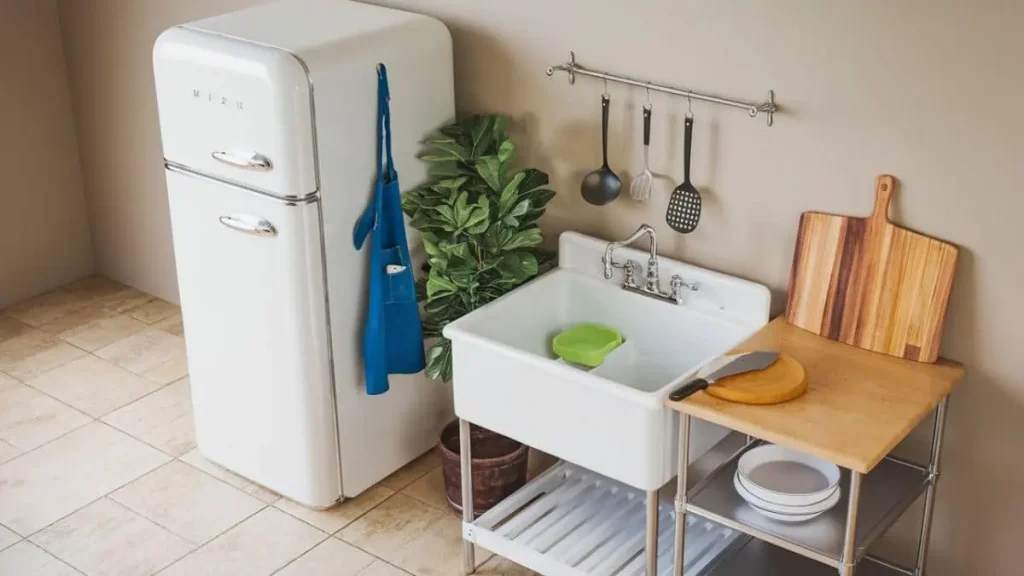
Choosing the Right Location for Your Dishwashing Station
Choosing the right location for your dishwashing station is crucial to make the process as convenient as possible. Ideally, you should set up your dishwashing area near your cooking station to minimize the time and effort spent carrying dirty dishes. If you’re using a portable water supply, make sure it’s easily accessible. For those using outdoor spaces, select a flat, stable surface, such as a patio or picnic table, where you can organize your cleaning supplies.
If you have a utility sink available elsewhere in your home, such as in a garage or laundry room, this can serve as a convenient option. However, in most cases, you’ll likely need to create a makeshift dishwashing station using portable supplies. For this, a folding table or countertop space works well to hold your wash and rinse basins, soap, and drying rack. Ensure that your chosen location is well-ventilated, especially if you’re using cleaning chemicals, and that it has good drainage to manage water runoff efficiently.
If you’re in the midst of a kitchen remodel and need a practical solution for washing dishes and food prep, setting up a temporary sink can be a game-changer. You can find step-by-step instructions in our detailed guide on how to set up a temporary sink during your kitchen remodel, which will ensure you stay efficient and organized while the major work is being done.
Setting Up a Two-Basin System for Washing and Rinsing
A two-basin system is an efficient and straightforward method for washing and rinsing dishes when you lack access to a traditional sink. In this setup, you’ll use one basin filled with warm, soapy water for washing and a second basin filled with clean water for rinsing. This system mimics a double sink and ensures that dishes are properly cleaned and rinsed, even when running water isn’t available.
To set up this system, you can use large plastic tubs or deep basins that are wide enough to accommodate most dishes and utensils. Place the basins side by side on a stable surface, such as a folding table or counter. Start by soaking the dirty dishes in the soapy water, scrubbing off food residue with a sponge or brush. Once clean, transfer the dishes to the rinse basin to remove any remaining soap.
If water access is limited, consider reusing water for multiple items before refreshing your basins. For example, wash cleaner items, like cups and utensils, first, followed by dirtier items, such as pans and cutting boards, to conserve water. Additionally, you can use a spray bottle filled with clean water to help rinse off soap suds before moving to the drying stage.
Drying and Storing Clean Dishes
After washing and rinsing your dishes, proper drying and storage are essential to prevent bacterial growth and keep your temporary kitchen organized. In a temporary kitchen, space for air-drying dishes may be limited, but with some planning, you can set up a drying area that works efficiently.
A collapsible drying rack is a great solution for temporary kitchens, as it can be folded and stored away when not in use. Position the rack near your washing station to minimize dripping and allow water to drain effectively. If you’re working outdoors or in a space without adequate ventilation, use clean, dry towels to hand-dry dishes to prevent water spots and avoid moisture buildup.
Once dry, make sure to store dishes in a clean, designated area to keep them free from dust or contamination. If you’re short on storage space, consider using stackable or collapsible storage bins for dishes, ensuring they stay organized and easy to access. Keeping clean dishes separate from any dirty dishes or cooking equipment is important for maintaining hygiene in your temporary kitchen.
Staying Flexible During the Remodel
During a kitchen remodel, one of the most important aspects of making it through the process smoothly is staying flexible. Remodeling projects can bring unexpected delays, changes, and challenges, and it’s crucial to adapt without letting it disrupt your routine too much. Flexibility in meal planning, workspace setup, and dealing with the inconveniences of construction can help you maintain a sense of normalcy, even as your home undergoes significant changes. In this section, we’ll explore practical ways to remain adaptable and minimize stress during the remodeling process.
Adapting to Changes in the Timeline
Kitchen remodels rarely go exactly as planned, and timelines often shift due to unforeseen circumstances like contractor schedules, supply delays, or unexpected issues with the structure. Being prepared to adjust to these changes is essential for maintaining your peace of mind.
Start by acknowledging that delays are a normal part of any renovation. Keep a backup plan in mind for an extended remodel by identifying other spaces in your home where you could cook or store food if the project takes longer than expected. For instance, you could rely more heavily on outdoor cooking or set up additional temporary storage in the garage or another room.
Instead of focusing on the frustrations that come with a disrupted timeline, try to anticipate delays and maintain open communication with your contractor. Regular updates on progress can help you plan accordingly, and when you know what to expect, you can adapt your schedule and meal prep around any changes. Remaining flexible and patient can make the experience less stressful.
Adjusting Your Meal Preparation
Flexibility in meal preparation is key to surviving the remodel. With limited resources and cooking tools in a temporary kitchen, your usual approach to cooking may need to change. While it can be tempting to maintain the same routine, adapting to simpler meals and creative cooking methods will ease the burden on both you and your temporary setup.
Embrace meals that require minimal cooking or no-cook options, especially during particularly busy phases of the remodel. Cold meals, like salads, wraps, or sandwiches, can provide healthy and easy alternatives when cooking feels too overwhelming. Similarly, one-pot meals, slow cooker dishes, or using a pressure cooker can simplify meal prep by reducing the number of appliances and dishes you need to manage.
If you have access to outdoor cooking equipment like a grill, you can expand your cooking options, but also be prepared to rely on quick, easy-to-assemble meals when the weather doesn’t cooperate or when construction makes things more challenging than usual. Being open to experimenting with different meal prep strategies will help you make the most of your temporary kitchen, even when resources are limited.
Managing Disruptions and Unexpected Challenges
No matter how well you plan, a remodel will inevitably cause disruptions to your daily routine. Construction noise, dust, limited access to certain parts of your home, and a rotating schedule of workers can make it hard to maintain a sense of order. However, by keeping a flexible mindset, you can manage these disruptions without feeling overwhelmed.
First, accept that disruptions will occur and try to prepare for them. Designate quiet or retreat spaces in your home where you can escape from the noise and chaos, and set boundaries for when workers are on-site so you have downtime to relax. Keeping certain areas of your home construction-free will provide a refuge from the mess and maintain some sense of control over your environment.
Unexpected challenges, like a water shut-off or a power outage, may arise during the remodel. Have a backup plan in place to manage these situations. Stock extra bottled water, easy-to-prepare snacks, or even pre-cooked meals that don’t require cooking to get through any short-term inconveniences. Keeping extra portable lighting, battery-powered fans, or space heaters can help maintain comfort when access to electricity is interrupted.
Flexibility also extends to your mindset. Rather than getting frustrated with unexpected challenges, try to view the remodeling process as a temporary inconvenience that brings lasting benefits. Acknowledging that each day brings you closer to a fully functional, newly remodeled kitchen can make it easier to stay positive.
Read Also: Do I Need Permit to Remodel Kitchen?
Conclusion
Setting up a temporary kitchen during a remodel may seem overwhelming at first, but with careful planning and a flexible approach, it’s entirely manageable. By thoughtfully organizing your temporary space, stocking it with essential items, and adapting your meal preparation to work within the constraints of limited resources, you can maintain a functional and comfortable kitchen environment throughout the renovation process.
Throughout this journey, maintaining hygiene and safety is crucial to ensuring a clean and secure space, while staying flexible will help you navigate the inevitable challenges and disruptions. Creating an efficient dishwashing station, making adjustments to your routine, and being prepared for delays are all vital components of making the remodeling period smoother.
Remember, the key to successfully managing a kitchen remodel is in maintaining balance. By focusing on short-term solutions, you can keep your household running smoothly while looking forward to the end result: a brand-new kitchen designed to meet your needs for years to come. While the temporary setup may have its limitations, with the right strategies, it can function as a reliable space that allows you to cook, clean, and carry on with your daily life until your dream kitchen is ready.

